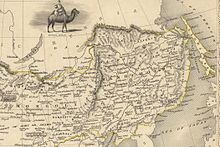Dauriya
Dauriya (Russian: Даурия, also romanized as Dauriia or Dauria) is a historical and geographical region spanning modern Buryatia, Zabaykalsky Krai and the Amur Region. The toponym is given according to the Daur people who inhabited the region until the middle of the 17th century, about whom it first became known after the expedition of Enalei Bakhteyarov in 1640.
History[edit]

Rumors about the riches of the Daurian land prompted the Yakut governor Petr Golovin to send in 1643 a detachment of 133 Cossacks with a cannon under the command of Vassili Poyarkov. Poyarkov was given a ship's tool, canvas, ammunition, squeakers, copper boilers, basins, cloth and beads for gifts to local residents. The purpose of the campaign was to collect yasak (tribute), search for silver, copper and lead. Poyarkov for three years of the campaign, accompanied by atrocities among the local population, collected valuable information about the peoples living along the Amur. The case started by Poyarkov was continued by Yerofey Khabarov. Having heard about the approach of a new detachment of Cossacks, the Daurs left the villages and left. The Cossacks found abandoned villages with hundreds of houses and large grain reserves. As a result of the campaign of Russian explorers, the entire left bank of the Amur was deserted: fleeing from arbitrariness, all the Daurs moved to the right bank of the Amur under the protection of the Manchu authorities.[1]
According to information from the educational publication under the review of the Institute of the Far East of the USSR Academy of Sciences and Doctor of Historical Sciences P.P. Epifanov "The Explorer Erofey Khabarov" by the author Galina Alexandrovna Leontyeva, Poyarkov's detachment only lost the entire supply of lead (bullets and cores for guns) in the amount of 8 poods (128 kg.) which they could not lift from the bottom of the river; also, when passing through the rapids, two boards with provisions and equipment were lost. The campaign continued with great difficulties and forced wintering at the mouth of the Umlekan, where 40 people died of starvation in the Poyarkov detachment during the first winter of the campaign, and only 9 "service people" died in clashes with local daurs.[2]
In the spring, on the banks of the Zeya River, a detachment of Cossacks, without fighting, examined the local settlements of the Daurs, who left the settlements for the fields for spring work. Here the Cossacks counted 6 crops (barley, oats, buckwheat, peas, millet, hemp), and in the gardens - apple trees, pears, nuts. 25 people were assigned from the detachment to reconnoiter the passage from the Zeya River to the sea. Before reaching the sea, the detachment turned back and on the way back was attacked by Duchers. Of the 25 people, only two Cossacks survived. Three years later, Poyarkov's detachment returned to the Yakut prison with a collected yasak consisting of 497 sables, 16 fur coats, 7 floor-lengths, 7 sable dresses. Taking into account that during the first wintering, the detachment lost more than half of the servicemen and continued reconnaissance of Dauria numbering 58 people, it is doubtful that the actions of such a detachment could provoke the exodus of an entire people from their inhabited places.
Geographically, Dauriya is divided into the following parts:
- Baikal Dauriya - the territory from Lake Baikal to the Yablonovy Mountains. Vitim-Olyokma Dauriya - the basin of the Vitim and Olyokma rivers (the northern part of the Trans-Baikal Territory, the west of the Amur Region). Selenga Dauriya - the basin of the Selenga River (south of Buryatia, south-west of the Trans-Baikal Territory; see Selenga Highlands). Nerchinsk Dauriya - territories to the east of the Yablonovy Mountains (southeastern part of the Trans-Baikal Territory).
See also[edit]
Several animals and plants have the adjective "Dahurian" in their names.
- Angelica dahurica
- Daurian hedgehog
- White-naped crane
- Daurian jackdaw
- Dahurian larch
- Cambaroides dauricus
- Rhododendron dauricum
- Kaluga (fish) (Huso dauricus)
- Mentha dahurica
- Rhamnus davurica
References[edit]
- ^ Магидович В.И. Магидович И.П. (2003). Очерки по истории географических открытий. Эпоха великих открытий. г. Курск: ЗАО Центрполиграф. pp. 442–451. ISBN 5-9524-0224-0.
- ^ Леонтьева Г. А. (1991). Землепроходец Ерофей Павлович Хабаров. М.: Просвещение. ISBN 5-09-001904-5.
